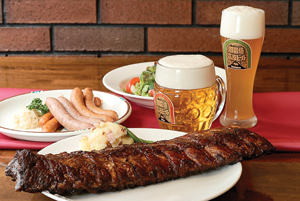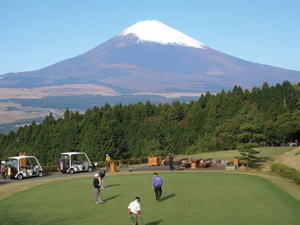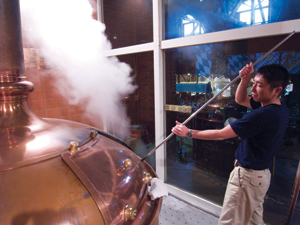The Good Beer, the Good Life
by Ry Beville

Gotemba Kogen Resort can make you feel as if you’ve gone down the proverbial rabbit hole, though this wonderland is a certifiably good one with something of interest for everyone, especially the craft beer lover. The sprawling campus is home to an array of lodging facilities, sports facilities, spas, playgrounds, unusual attractions, shops, restaurants and, of course, a brewery with an impressive beer hall to match. The surrounding area boasts outlet shopping and over twenty golf courses, too. You’d need several days to properly enjoy all that’s on offer.
It would be inaccurate to call Gotemba a theme park. There is no overall theme except perhaps making people happy–that’s president Shoji Kiyokazu’s conception of the place, at least. It’s evident he’s built it out to be family friendly, with an emphasis on domestic tourism. Also obvious is that neither he nor the board feels constrained by expense when it comes to buying something they like and think Gotemba needs. Huge, specially commissioned sculptures dot the campus. Atop a hill lies the world’s largest swinging bell, which requires ten men to ring it; nearby, an arena for a laser-light show. A 3D movie theater is one of a dozen other surprising, eclectic entertainment facilities. Let’s go on: echo domes, winter illumination consisting of four million lights, a synthetic ice-skating rink that doesn’t require ice, petting farms, pottery studios, Segways… there’s even a hillside with hundreds of Buddhist statuettes.
But we came mostly for the beer.
Sales and marketing director Bennett Galloway greets us, and we’re joined by Scott Brimmer, the former head brewer who still maintains close ties with Gotemba after having left recently to launch his own brewery, Brimmer Brewing, in Kawasaki later this year. We enter through the back of the brewery where an assistant is collecting dried, spent grain that has gone through a vacuum dryer. The flaky material is sent to famed food producer Yonekyu (the backbone of the business conglomerate of which Gotemba is a part), where it is used as a medium for growing mushrooms.
The brewery is much smaller than we expected, until our hosts remind us that Yonekyu has its own, much larger, brewing facilities on its campus. The one we’re entering runs nearly at capacity simply to fulfill demand at the places on the resort where guests can enjoy it. Although the brewing facilities, as well as the brewers, are different, Scott claims that only the most discerning drinker would detect a difference in taste between the same beers made at Yonekyu and Gotemba.
The brewhouse is lovely and looks out through glass onto Grand Table, one of Gotemba’s several restaurants. The brew house actually acts as a backdrop to a stage where musicians perform regularly–live music is everywhere around the resort.
An almost cinnamon aroma wafts from one of the open mash tuns, as if we are in a bakery, though that is actually on another part of the resort. The aromas are enough to make you thirsty for the final product. The brewery is, consistent with a place producing such high-quality brew, immaculate. Sanitation issues do not plague Gotemba. Some of the conditioning tanks are connected directly to servers in Grand Table, ensuring peak freshness.
Scott explains that after his arrival from Sierra Nevada Brewing, his largest contribution was in the brewing process, not the recipes. The beer was good, but could be made better. He slowed down critical segments, such as the lautering, so that the wort wasn’t carrying so many bits of grain to the boiler kettle, thus imparting an undesirable sourness to the beer. It added time to the process, but also quality.
The development of the recipes was more organic in nature. Sure, there was once a German brewmaster who brought recipes and trained the original staff, but those recipes have gone through so many adjustments over time that they have taken on a life of their own. Different brewers in both the Gotemba and Yonekyu breweries claim to have contributed essential adjustments to certain beers, but in the end it all becomes confused and seems like nobody has proprietary claim to any of the beers. Current head brewer Kadokura Sakae of course has to control quality and call the shots, but Gotemba’s line-up is the result of team effort and, in our opinion, a spirited one; there were no sub-standard beers in the restaurant, not by a long shot.
We dived into dinner at Mugi-Batake, a buffet restaurant featuring over forty dishes from around the world, including Japanese, Thai, Chinese, Italian, Indian, European and American. Chefs grilled up Australian steak right before our eyes. We snapped up some delicately fried tempura as soon as it hit the serving plates. Naturally, we couldn’t resist piling up some sausages. For 80 minutes and a mere ¥3150, it was all-you-can-gorge-on. Oh yes, and drink, too.
The beers on tap at the time of our visit were decidedly German in tradition: Dunkel, Pils, Schwartz, Weizen and Weizenbock. The Weizen was perfectly balanced, with lovely but subtle clove flavor and none of that dominant banana bubble-gum sugariness so common to inferior weizens. The darker Weizenbock was a masterpiece, with dark-fruit aromas, slightly spicy wheat flavor and a full body to warm the bones with a 7% ABV. Our personal favorite, however, was the Schwarz, a quintessential dark German beer with coffee notes, slightly bitter chocolate flavor balanced by a roastiness that lingers through the finish. This was dessert, several times over.
Our seats looked out onto a FIFA-certified field where groups of kids were practicing, future stars, maybe, because Gotemba gave them a chance: they were refugees. Since early April, Gotemba has been giving shelter to over 100 kids from the JFA Academy Fukushima. Having left their homes because of the radiation, they are staying in some of the ample lodging at the resort and making good use of the many athletic fields. Gotemba Resort didn’t greatly publicize the fact to attract new customers or show off its CSR. It just simply did it.
The kids were staying in condominiums that are also available to other guests, but the entire range of lodging at Gotemba varies dramatically, from somewhat weathered old igloo-shaped lodges to pristine hot-spring resort facilities and business accommodations. There are even teepees–we’re serious. The best rooms at the resort are probably those at the top of Hotel Toki no Sumika with views of Mt. Fuji across the valley. But naturally Gotemba resort is popular, and especially on weekends and holidays, patrons have booked their accommodations months in advance.
During part of our walk around the resort, we encounter president Shoji himself, an unassuming, elderly man in ordinary clothing who seems just like another patron taking a quiet stroll through the trees. He was probably observing the interaction of the guests on his vast playground, or musing over what to add next.
“Have you seen the laser show yet?”
There is a flicker of warmth in his eyes, a hint of pride in his voice. And his wish for me to see one of his attractions has a boyish charm to it.
“No I haven’t; unfortunately we’re heading to the restaurant now.”
“Well, come by later if you have the chance.”
We didn’t. After a feast and copious pints at the restaurant, we were homeward bound. But we’ll be back. If not for the lasers, the spas, the golf–you name it–then certainly for the beer. Certainly for the beer.\r



Gotemba Kogen Resort
(English): www.gotembakogenresort.jp
(Japanese): www.tokinosumika.com
For golf: www.golf-shizuoka.com
(includes links to other great activities in the area)
Golf inquiries (e-mail): info[at]golf-shizuoka.com
Head Brewer Kadokura Sakae

When did you join Gotemba and whom did you learn brewing from?
I joined the service department in 1997, but had an interest in beer and moved to that department in 1998. The brewmaster at the time was a man named Anton Danner, who, along with other senior colleagues, trained me. I learned brewing from all of them.
How much do you brew each year now?
Right around 400 kiloliters.
You’ve probably tweaked a few of the recipes, haven’t you?
I switched our standard Dunkel to a Schwartzbier. That Schwartzbier recipe was a seasonal but I tweaked it to make it the beer we now serve. Since we also have a happoshû license, I made a honey-lemon pilsner as a seasonal–we still serve it. I’ve tweaked a few other beers, but recently I haven’t really touched anything.
What kinds of beers are you thinking of making down the road?
I really like lagers. I’ve set making a Dortmunder as a goal for myself, but considering how difficult it might be to distinguish it from our pilsner, it’s kind of a non-starter. I also want to make a pilsner that is more refined than your European pilsner and so fresh you can session with it.
This article was published in Japan Beer Times # () and is among the limited content available online. Order your copy through our online shop or download the digital version from the iTunes store to access the full contents of this issue.



